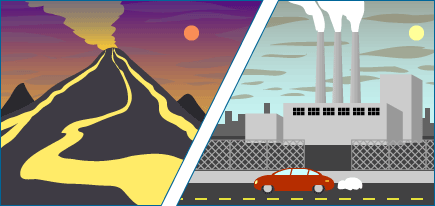Jennifer’s work helps us piece together the big picture of how Earth’s climate has changed over time and how those changes have affected life’s diversity. She relies on diverse sources of data (from mathematical models to experiments to basic geology) combined with her detailed studies of fossil leaves – details as seemingly trivial as the number of tiny pores on the surface of an ancient leaf – to reconstruct the climates in which those plants once lived.

This work highlights the fundamental similarities between catastrophic events in Earth’s history and the sorts of environmental changes that humans are bringing about today, with our steady production of carbon dioxide and other greenhouse gasses through the burning of fossil fuels. Thus, an understanding of Earth’s history may help us predict our impact on global environmental cycles tomorrow. As Jennifer explains, “The importance of the work today…is that the carbon cycle typically takes about one million years to come back into balance (or equilibrium) after a perturbation, so even if we stopped burning fossil fuels today, we still would feel the effects of what we’ve done today for the next 200 years — and it could take hundreds of thousands to even a million years for it all to come back into equilibrium. So people think, ‘Oh, we don’t need to worry because…the climate’s not going to warm in the next ten or 50 years,’ but if we think of our children or our children’s children, there are going to be major changes because of what we’re doing today. And that’s just how the carbon cycle works — there’s a lag time.”
Jennifer is particularly interested in how such environmental changes are likely to affect global biodiversity: “The big question we’re addressing and want to address in the future is how do changes in greenhouse gasses – increases in greenhouse gasses and global warming – influence the biodiversity and ecology of natural ecosystems, because this is particularly relevant to today.” Next she intends to revisit fossils from the end-Triassic mass extinction to find out if different sorts of organisms are affected differently by climate change. As she explains, “What I’m trying to do by studying the Triassic/Jurassic boundary is to work out if there are any particular ecological traits – rarity or dominance or reproductive specialization – that increase a species’ vulnerability to extinction, that make it more likely to go extinct as global climate changes. I’m hoping that if I can study enough of these events in the fossil record, I might be able to make broad predictions on which species today will be most vulnerable as global warming continues over the next 50 to 100 years. That’s the big burning question at the moment.” — and she just got a new grant from the European Union to answer it, so stay tuned!
Discussion and extension questions:
- What trade-off does a plant face by opening its stomata?
- Why do plants in high carbon dioxide environments tend to have fewer stomata?
- How does carbon dioxide level affect global temperatures?
- How does Jennifer use fossils to learn about past climates on Earth?
- What is a mass extinction?
- What was Jennifer’s hypothesis about the cause of the end-Triassic mass extinction? How did information from fossil leaves relate to this hypothesis?
- List some similarities and differences between the mid-Jurassic event described here and how humans are influencing the climate and ecosystems today.
Get tips for using research profiles, like this one, with your students.
